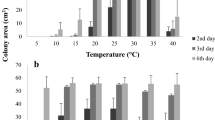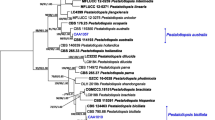Abstract
The ability of species in the Botryosphaeriaceae to inhabit seemingly healthy plants, reside as endophytes yet result in serious disease under stressful environmental conditions is poorly understood, as is their ability to colonise many unrelated hosts often without causing disease. Although many species of Botryosphaeriaceae have a wide host range, there is dearth of information on pathogenic variation of isolates of the same species on different hosts. In this study we used 16 isolates belonging to two genera of Botryosphaeriaceae from seven host plant species, to test the hypothesis that there are significant differences in pathogenic variation, varietal preferences and cross-pathogenicity in Botryosphaeriaceae on two unrelated host crops (macadamia and blueberry). Using the detached leaf and stem inoculation assays, we observed significantly (P < 0.05) high levels of pathogenic variation among isolates of Neofusicoccum parvum and compared with three other Neofusicoccum spp. and the three Lasiodiplodia spp. Host specificity was not observed among the isolates, as all were pathogenic on both hosts, but the aggressiveness of the isolates varied on the hosts, regardless of the source of the isolates. Between the host plants, blueberry was significantly more susceptible, regardless of the isolates than macadamia. There were significant (P < 0.03) differences among the four macadamia cultivars, isolates and cultivar × isolate interaction. Similar results for pathogenicity, aggressiveness and pathogenic variations were obtained using both the detached leaf and stem inoculation assays. Implications of these findings for disease management in cropping systems are discussed.





Similar content being viewed by others
References
Adesemoye AO, Mayorquin JS, Wang DH, Twizeyimana M, Lynch SC, Eskalen A (2014) Identification of species of Botryosphaeriaceae causing bot gummosis in citrus in California. Plant Dis 98:55–61
Akinsanmi O (2016) Branch dieback: a growing threat. Australian Macadamia Society Ltd News Bulletin 44(1):58–59
Billones-Barnes R, Jaspers M, Allard A, Hong Y, Ridgway H, Jones E (2015) Management of Botryosphaeriaceae species infection in grapevine propagation materials. Phytopathol Mediterr 54:355–367
Brooks FE (2008) Detached-leaf bioassay for evaluating taro resistance to Phytophthora colocasiae. Am Phys Soc 92:126–131
de Oliveira Costa VS, Michereff SJ, Martins RB, Gava CAT, Mizubuti ESG, Câmara MPS (2010) Species of Botryosphaeriaceae associated on mango in Brazil. Eur J Plant Pathol 127:509–519
Harteveld DOC, Akinsanmi OA, Drenth A (2014) Pathogenic variation of Alternaria species associated with leaf blotch and fruit spot of apple in Australia. Eur J Plant Pathol 139:789–799
Ireland KB, Hüberli D, Dell B, Smith IW, Rizzo DM, Hardy GESJ (2012) Potential susceptibility of Australian flora to a NA2 isolate of Phytophthora ramorum and pathogen sporulation potential. For Pathol 42:305–320
Ma ZH, Morgan DP, Michailides TJ (2001) Effects of water stress on Botryosphaeria blight of pistachio caused by Botryosphaeria dothidea. Plant Dis 85:745–749
Marques WM, Lima NB, Morais Junior MA, Barbosa MAG, Souza BO, Michereff SJ, Phillips AJL, Camara MPS (2013) Species of Lasiodiplodia associated with mango in Brazil. Fungal Divers 61:181e193
McDonald V, Eskalen A (2011) Botryosphaeriaceae species associated with avocado branch cankers in California. Plant Dis 95:1465–1473
Mohali SR, Slippers B, Wingfield MJ (2007) Identification of Botryosphaeriaceae from Eucalyptus, Acacia and Pinus in Venezuela. Fungal Divers 25:103–125
Netto MS, Lima WG, Correia KC, Da Silva CF, Thon M, Martins RB, Miller RN, Michereff SJ, Camara MP (2017) Analysis of phylogeny, distribution, and pathogenicity of Botryosphaeriaceae species associated with gummosis of Anacardium in Brazil, with a new species of Lasiodiplodia. Fungal Biol 121:437–451
Olmo D, Armengol J, Leon M, Gramaje D (2016) Characterization and pathogenicity of Botryosphaeriaceae species isolated from almond trees on the island of Mallorca (Spain). Plant Dis 100:2483–2491
Pariaud B, Ravigné V, Halkett F, Goyeau H, Carlier J, Lannou C (2009) Aggressiveness and its role in the adaptation of plant pathogens. Plant Pathol 58:409–424
Scarlett KA, Shuttleworth LA, Collins D, Rothwell CT, Guest DI, Daniel R (2018) Botryosphaeriales associated with stem blight and dieback of blueberry (Vaccinium spp.) in New South Wales and Western Australia. Australas Plant Pathol. https://doi.org/10.1007/s13313-018-0584-6
Slippers B, Wingfield MJ (2007) Botryosphaeriaceae as endophytes and latent pathogens of woody plants: diversity, ecology and impact. Fungal Biol Rev 21:90–106
Slippers B, Crous PW, Jami F, Groenewald JZ, Wingfield MJ (2017) Diversity in the Botryosphaeriales: looking back, looking forward. Fungal Biol 121:307–321
Urbez-Torres JR, Peduto F, Vossen PM, Krueger WH, Gubler WD (2013) Olive twig and branch dieback: etiology, incidence, and distribution in California. Plant Dis 97:231–244
Vawdrey LL, Martin TM, De Faveri J (2005) A detached leaf bioassay to screen durian cultivars for susceptibility to Phytophthora palmivora. Australas Plant Pathol 34:251–253
Xu C, Zhang H, Zhou Z, Hu T, Wang S, Wang Y, Cao K (2015) Identification and distribution of Botryosphaeriaceae species associated with blueberry stem blight in China. Eur J Plant Pathol 143:737–752
Yang T, Groenewald JZ, Cheewangkoon R, Jami F, Abdollahzadeh J, Lombard L, Crous PW (2017) Families, genera, and species of Botryosphaeriales. Fungal Biol 121:322–346
Acknowledgements
We thank Mr. Lachlan Fowler of the University of Queensland, School of Agriculture & Food Sciences for technical and laboratory support. This study was supported by funds from MC12007 and MC16018 projects funded by Horticulture Innovation Australia Limited using the macadamia research and development industry levy and funds from the Australian Government.
Author information
Authors and Affiliations
Corresponding author
Rights and permissions
About this article
Cite this article
Liddle, R.L., Akinsanmi, O.A. & Galea, V.J. Non-host specificity of Botryosphaeriaceae on macadamia and blueberry. Australasian Plant Pathol. 48, 65–73 (2019). https://doi.org/10.1007/s13313-018-0600-x
Received:
Accepted:
Published:
Issue Date:
DOI: https://doi.org/10.1007/s13313-018-0600-x




